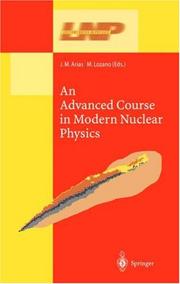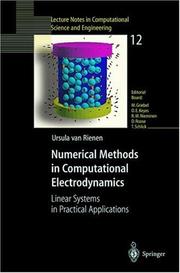| Listing 1 - 4 of 4 |
Sort by
|
Book
Year: 2001 Publisher: Adelphi, MD : U.S. Army Research Laboratory,
Abstract | Keywords | Export | Availability | Bookmark
 Loading...
Loading...Choose an application
- Reference Manager
- EndNote
- RefWorks (Direct export to RefWorks)
Molecular beam epitaxy --- SDL (Computer program language) --- Automation.
Book
Abstract | Keywords | Export | Availability | Bookmark
 Loading...
Loading...Choose an application
- Reference Manager
- EndNote
- RefWorks (Direct export to RefWorks)
Lithography, Electron beam --- Masks (Electronics) --- Microlithography --- X-ray lithography --- X-rays --- Industrial applications

ISBN: 3540424091 3540446206 Year: 2001 Volume: 581 Publisher: Berlin ; New York : Springer,
Abstract | Keywords | Export | Availability | Bookmark
 Loading...
Loading...Choose an application
- Reference Manager
- EndNote
- RefWorks (Direct export to RefWorks)
The field of nuclear physics is entering the 21st century while experiencing a strong revival. On the one hand it is changing qualitatively through new experimental developments that allow us to direct radioactive and other exotic probes to target nuclei, and spark off extremely energetic nuclear collisions. Also, the impressive sophistication of new detector systems leads us to expect a number of new discoveries in the near future. On the other hand many new applications have appeared in fields as diverse as medicine, industry, art, archaeology and the environmental sciences. This book is a set of extended lectures on basic and new topics, that gives a tutorial introduction to the field of modern nuclear physics. It is ideally suited to bridging the gap between the standard textbook material and the research literature, and provides the necessary foundation for acting as those who intend to work in any of the many disciplines where nuclear science and technology is going to play an important role in the future.
Nuclear physics. --- Physique nucléaire --- Nuclear fusion. --- Particle acceleration. --- Nuclear Physics, Heavy Ions, Hadrons. --- Nuclear Fusion. --- Particle Acceleration and Detection, Beam Physics. --- Particles (Nuclear physics) --- Acceleration (Mechanics) --- Nuclear physics --- Fusion, Nuclear --- Fusion reactions --- Fusion --- Nuclear reactions --- Atomic nuclei --- Atoms, Nuclei of --- Nucleus of the atom --- Physics --- Acceleration --- Heavy ions. --- Ions

ISBN: 3540676295 3642568025 9783540676294 Year: 2001 Publisher: Berlin New York Springer
Abstract | Keywords | Export | Availability | Bookmark
 Loading...
Loading...Choose an application
- Reference Manager
- EndNote
- RefWorks (Direct export to RefWorks)
treated in more detail. They are just specimen of larger classes of schemes. Es sentially, we have to distinguish between semi-analytical methods, discretiza tion methods, and lumped circuit models. The semi-analytical methods and the discretization methods start directly from Maxwell's equations. Semi-analytical methods are concentrated on the analytical level: They use a computer only to evaluate expressions and to solve resulting linear algebraic problems. The best known semi-analytical methods are the mode matching method, which is described in subsection 2. 1, the method of integral equations, and the method of moments. In the method of integral equations, the given boundary value problem is transformed into an integral equation with the aid of a suitable Greens' function. In the method of moments, which includes the mode matching method as a special case, the solution function is represented by a linear combination of appropriately weighted basis func tions. The treatment of complex geometrical structures is very difficult for these methods or only possible after geometric simplifications: In the method of integral equations, the Greens function has to satisfy the boundary condi tions. In the mode matching method, it must be possible to decompose the domain into subdomains in which the problem can be solved analytically, thus allowing to find the basis functions. Nevertheless, there are some ap plications for which the semi-analytic methods are the best suited solution methods. For example, an application from accelerator physics used the mode matching technique (see subsection 5. 4).
Electrodynamics --- Numerical analysis. --- Mathematics. --- 519.63 --- Numerical analysis --- Mathematical analysis --- 519.63 Numerical methods for solution of partial differential equations --- Numerical methods for solution of partial differential equations --- Computers. --- Optics. --- Electrodynamics. --- Engineering. --- Computational intelligence. --- Particle acceleration. --- Theory of Computation. --- Classical Electrodynamics. --- Engineering, general. --- Numerical Analysis. --- Computational Intelligence. --- Particle Acceleration and Detection, Beam Physics. --- Particles (Nuclear physics) --- Acceleration (Mechanics) --- Nuclear physics --- Intelligence, Computational --- Artificial intelligence --- Soft computing --- Construction --- Industrial arts --- Technology --- Dynamics --- Physics --- Light --- Automatic computers --- Automatic data processors --- Computer hardware --- Computing machines (Computers) --- Electronic brains --- Electronic calculating-machines --- Electronic computers --- Hardware, Computer --- Computer systems --- Cybernetics --- Machine theory --- Calculators --- Cyberspace --- Acceleration
| Listing 1 - 4 of 4 |
Sort by
|

 Search
Search Feedback
Feedback About UniCat
About UniCat  Help
Help News
News